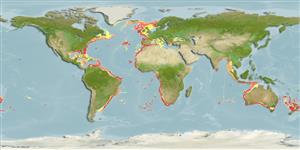Teleostei (teleosts) >
Acropomatiformes (Oceanic basses) >
Epigonidae (Deepwater cardinalfishes)
Etymology: Epigonus: Greek, epi = over, in front + Greek, gonio = angle (Ref. 45335).
More on author: Risso.
Environment: milieu / climate zone / depth range / distribution range
Ecology
Marine; bathydemersal; depth range 75 - 1305 m (Ref. 4738), usually 300 - 800 m (Ref. 4738). Deep-water; 65°N - 43°S
North Atlantic: Iceland to the Canary Islands and Corner Seamounts. One specimen off North America (Ref. 7321). Southeast Atlantic, Indian and Southwest Pacific: Walvis Ridge off southwestern Africa to New Zealand.
Length at first maturity / Size / Weight / Age
Maturity: Lm 56.0 range ? - ? cm
Max length : 75.0 cm TL male/unsexed; (Ref. 5755); common length : 55.0 cm TL male/unsexed; (Ref. 9258); max. reported age: 104 years (Ref. 39263)
Dorsal spines (total): 7 - 8; Dorsal soft rays (total): 9 - 11; Anal spines: 2; Anal soft rays: 9. No opercular spines. 8 spines on first dorsal fin (Ref. 31632). Snout blunt, eye large. Mouth large, lower jaw equaling or slightly protruding beyond upper jaw. Pyloric caeca 21-34. Brown-violet or black, iridescent in life.
Body shape (shape guide): fusiform / normal.
Adults benthic or benthopelagic on the continental slopes; juveniles pelagic (Ref. 7321). Found on soft bottoms (Ref. 27121). Non-territorial. Carnivorous, feed on small fishes and planktonic invertebrates.
Maugé, L.A. and G.F. Mayer, 1990. Apogonidae. p. 714-718. In J.C. Quero, J.C. Hureau, C. Karrer, A. Post and L. Saldanha (eds.) Check-list of the fishes of the eastern tropical Atlantic (CLOFETA). JNICT, Lisbon; SEI, Paris; and UNESCO, Paris. Vol. 2. (Ref. 7321)
IUCN Red List Status (Ref. 130435: Version 2025-1)
Threat to humans
Harmless
Human uses
Fisheries: commercial
Tools
Special reports
Download XML
Internet sources
Estimates based on models
Preferred temperature (Ref.
123201): 4.6 - 13.8, mean 8.9 °C (based on 755 cells).
Phylogenetic diversity index (Ref.
82804): PD
50 = 0.5000 [Uniqueness, from 0.5 = low to 2.0 = high].
Bayesian length-weight: a=0.01950 (0.01155 - 0.03291), b=2.98 (2.83 - 3.13), in cm total length, based on LWR estimates for this species & Genus-body shape (Ref.
93245).
Trophic level (Ref.
69278): 3.6 ±0.3 se; based on diet studies.
Generation time: 28.9 ( na - na) years. Estimated as median ln(3)/K based on 1
growth studies.
Resilience (Ref.
120179): Very Low, minimum population doubling time more than 14 years (tmax=104; K=0.03; tm=36.6;).
Prior r = 0.14, 95% CL = 0.09 - 0.21, Based on 1 data-limited stock assessment.
Fishing Vulnerability (Ref.
59153): High to very high vulnerability (69 of 100).
🛈
Climate Vulnerability (Ref.
125649): Low to moderate vulnerability (32 of 100).
🛈
Nutrients (Ref.
124155): Calcium = 14.5 [8.2, 37.5] mg/100g; Iron = 0.392 [0.168, 0.802] mg/100g; Protein = 17.4 [16.4, 18.4] %; Omega3 = 0.338 [0.181, 0.623] g/100g; Selenium = 21.4 [8.2, 65.4] μg/100g; VitaminA = 17.8 [3.5, 96.3] μg/100g; Zinc = 0.422 [0.264, 0.674] mg/100g (wet weight);
